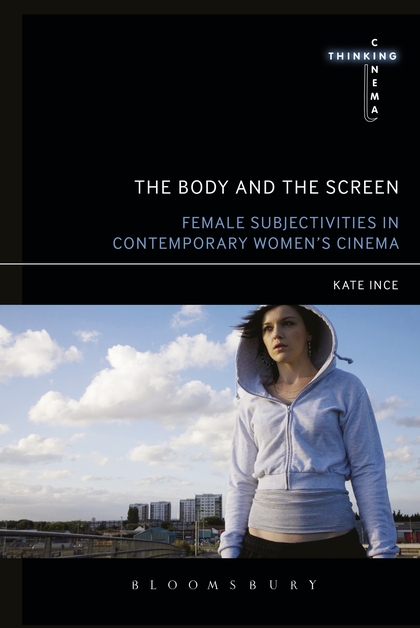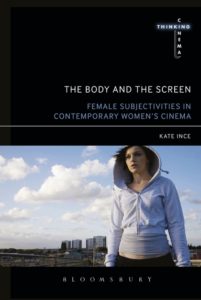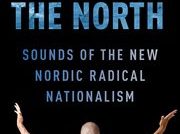
 The Body and the Screen, published in the Thinking Cinema series is a timely contribution to the field of film philosophy and feminism. Since the 1980s, Western countries have seen an increasing number of films by female directors who challenge the mainstream representation of women, and attempt to present women’s lives and identities in a new light. Kate Ince’s volume offer new readings of several key French and British female filmmakers of the last twenty-five years, and shows that feminist philosophers can provide the tools for rethinking female subjectivities in cinema. As no single study has yet been undertaken to scrutinize embodied female subjectivity in film, The Body and the Screen is of considerable interest to film and feminist scholars.
The Body and the Screen, published in the Thinking Cinema series is a timely contribution to the field of film philosophy and feminism. Since the 1980s, Western countries have seen an increasing number of films by female directors who challenge the mainstream representation of women, and attempt to present women’s lives and identities in a new light. Kate Ince’s volume offer new readings of several key French and British female filmmakers of the last twenty-five years, and shows that feminist philosophers can provide the tools for rethinking female subjectivities in cinema. As no single study has yet been undertaken to scrutinize embodied female subjectivity in film, The Body and the Screen is of considerable interest to film and feminist scholars.
The book opens with a very careful overview of the theories of female subjectivity offered by Simone de Beauvoir, Luce Irigaray, and Christine Battersby that frame the film analyses developed in the rest of the book. Ince demonstrates that what brings the three feminist philosophers together are their “feminist ethics of embodiment,” and suggests that the future of feminist film study lies in the philosophical understanding of female subjectivity as embodied and ethical.
Before undertaking the film analyses, Ince devotes her second chapter to an overview of feminist film studies and women’s cinema after the psychoanalytic turn of the ’70s. She consciously ignores the use of Freudian and Lacanian accounts of femininity in cinema although they were central to feminist film theory. She justifies her position by asserting that psychoanalytic feminist film theory failed to offer a satisfactory account of female subjectivity “one that integrates embodiment and is sufficiently historically flexible to take account of non-white and other-than-heterosexual female identities”(3). Large sections of this chapter concern the work of Teresa de Lauretis, Vivian Sobchack, and Gylyn Studlar, but it is the examination of the contributions of Constable, Bainbridge, Bolton, and Chamarette to feminist film-philosophy that represent the most interesting and useful part of this overview. Ince clearly situates her study in continuity with the work on film and feminist phenomenology of these four authors which she considers to be breaking new ground in feminist film studies, and to be representing a type of philosophical enquiry into film her book intends to add to. (41).
Ince then sets herself to revealing the method she will be using to study female subjectivities in film. Her readings, she contends, will be guided by her attention, not only to the agency of the female characters, to the bodily and emotional experiences and intersubjective encounters, but to the “dynamics of feminine intersubjectivity detectable between director and character, and between character and viewer” (42). In spite of Ince’s stated method, the intersubjectivity between the films and the viewers are not thoroughly studied, and the chapters tend to concentrate on the analyses of female characters. Laura Mulvey’s seminal article “Visual Pleasure and Narrative” is still very influential in Ince’s method, which privileges the visual aspect of cinema at the expense of the sound. Ince devotes a chapter to ‘“Speech” but regrettably, little space is devoted to sound, music, and silence. In spite of a desire to present a renewal of feminist film theory, Ince’s book respects the hierarchy between image and sound, and within sound, the privilege given to the voice. Luce Irigaray had brought up the subject of the domination of visuality at the expense of aurality as reflecting the power relation between the masculine and the feminine, but this aspect of Irigaray’s work could have been given more attention in the film analyses of female subjectivities undertaken by Ince.
In addition to the two theoretical overviews, the study of films is divided into six chapters: “Body,” “Look,” “Speech,” “Performance,” ”Desire,” and “Freedom,” with the first of those chapters introducing four of the film-makers central to the book: Andrea Arnold, Sally Potter, Agnès varda and Catherine Breillat. It also offers close readings of Fish Tank, Orlando, The Tango Lesson, The Beaches of Agnès, The Gleaners and I and Romance, using a feminist phenomenological approach. It successfully shows that such an approach can bring out the embodied agency, movements and actions of the female protagonists.
The chapter on the “Look” focuses, as expected, on the concept of the gaze in four films Orlando, The Tango Lesson, Brief Crossing (Breillat), Red Road (Arnold). Mulvey’s hierarchical division of the gaze into active-sadistic and passive-masochistic forms is, according to Ince, no longer useful since agentic looking is now very common in films. It should be replaced by a feminist phenomenological approach. Breillat and Potter’s dramas have been able to tackle the consequences of this new male-female intersubjectivity so it is now time for an exploration of the phenomenological ethical vision carried out by female characters (92), which is the subject of the study of this section on the “look.”
The chapter on “Speech,” which includes the study of dialogues and voice over, draws on Irigraray’s work on gendered speech and parler femme, to analyse Gorris’s Mrs Dalloway and three films directed by Breillat: Nocturnal Uproar, Romance and Brief Crossing. The study focuses on the speech of the female protagonists as representing female subjectivity, however the effects of the materiality of the voice, such as intonation, timbre, tone etc. are not fully considered. Such a focus on speech at the expense of the materiality of the voice and its effects is regrettable considering the development of scholarly research currently undertaken on sound in cinema.
In the chapter on performance, the question of the dramatized subjectivity of the female director is considered. Films by Calle (No sex tonight), Ionesco (My Little Princesss), Potter (The Tango Lesson), and Masson (Why (not) Brazil), in which directors film their own lives, are examined. The choice of films is particularly interesting and so is the angle of analysis. While the directors adopt different strategies of representation of their lives, they all provide relevant material to the question of female subjectivity. In fiction films, imaginary protagonists offer imaginary subjectivities, but the self-reflexive approach is here particularly relevant to the study because the films function as documentary-style performances of self.
The desire of female protagonists is the topic of the seventh chapter. Ince discusses four films of the early and late 2000s: Andrea Arnold’s Fish Tank, Lynne Ramsey’s MorvenCallar, Claire Denis’s White Material, and Catherine Breillat’s Sex is Comedy. After an introductory section on Irigaray’s approach to desire “involving a redistribution of the death drive,” the author points out that aggression and violence are central to the actions of the female protagonists of the four films. Their extreme behaviour is in the pursuit of survival or in order to escape or to become more independent. Desire at no time is conceived as an essentialist drive, but rather at the product of circumstances and social contexts. Ince also suggests that “their challenge to conventional ‘civilized’ (patriarchal) morality might just represent the beginnings of a new and sexuate ethical and moral order” (151).
The last chapter “Freedom” is clearly linked to existentialist thought and to Beauvoirian feminism. It focuses on the theme of sexual freedom as represented by the female protagonists of Breillat’s films Romance, Brief Crossing, Claire Denis’s Friday Night, and Cécile Sciamma’s Girlhood. Ince examines sexual freedom exercised by characters in Breillat’s films and the “strikingly sensory, sensual feelings of freedom experienced by Laure in Denis’s Friday Night” (171), whereas in Girlhood, the emphasis is on freedom of movement and action of the female protagonists, and their solidary against patriarchal oppression. The analysis of a recent film such as Girlhood, which centres on black female characters from the Paris suburb, is a welcome addition to the already varied range of films under study.
The book is limited to the study of female protagonists and remains a textual reading of cinema. The six chapters on specific films would provide excellent stand-alone readings and film analysis models for film and gender studies students. The choice of films offers an excellent range and the close readings are insightful, although the study doesn’t take into account the recent scholarship on embodied spectatorship, the synesthetic turn, studies on the haptic in cinema and on perception of the audio-visual medium by audiences, which would also need investigating in the context of feminist film studies. In spite of its limits, The Body and the screen makes a fine contribution to the field of film philosophy in its examination of how feminist phenomenology can be brought into dialogue with female subjectivity in film.
Reviewed by Michelle Royer, University of Sydney
The Body and the Screen: Female Subjectivities in Contemporary Women’s Cinema
by Kate Ince
Publisher: Bloomsbury
Hardcover / 208 pages / 2017
ISBN: 978-1623565817
To read more book reviews, please click here.
Published on February 1, 2018.




